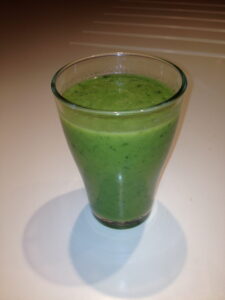 “What is that green drink”, my patients ask me with a look of horror and disbelief, half concealed by polite respect, all over their faces.
“What is that green drink”, my patients ask me with a look of horror and disbelief, half concealed by polite respect, all over their faces.
“Good question, everybody always asks” I reply, smiling.
So here’s the answer to all those good folks who have asked me that very question when they see this “green” drink on my desk at work. And to whom I’ve never really had the time to explain it fully.
Here’s the method and list of ingredients:
Juice (using a juice extractor) of 1 peeled cucumber, 4 sticks celery, 1 un-waxed lemon, 1-inch fresh ginger root, 2 apples. I juice these so as to extract as much “natural living water” from them as possible.
Once juiced, I put this into a blender along with 1 or ½ a big avocado, a handful of spinach leaves, a handful of parsley leaves and a peeled pear. I blend these last ingredients because that adds thickness to the drink but more importantly, it preserves the fibre, which I have lost by juicing the first set of ingredients.
Blend all together and drink fresh that day, (ok, so I make mine the night before). If you can get organic ingredients, so much the better. I have read that the foods one consumes the most, should be the ones you buy organically. That makes sense logically. If you’re going to eat a lot of something then it should be as high a quality as you can afford. I peel the cucumber only because the skin contains most of the pesticide residues. This quantity makes a little less than a litre.
Obviously, I wash all the ingredients thoroughly, as I will be consuming them raw. Tips: Make sure the avocado is properly ripe so that it blends smoothly. Remove the parsley and spinach stalks as they make the juice too “bitty”. Use them in your stir-fry’s instead.
I would use kale if I could get it, (it’s obviously not in demand in the UAE) or watercress, mint, coriander, pak choi or any really dark green leaved vegetable or herb that your palate enjoys. Similarly, you can alter any of the ingredients and quantities depending on your nutritional needs and tastes. My husband drinks his on the way to work in the morning, says it has a kick like a mule and swears it beats a “Red Bull” to get his brain going any day!
Anyway back to the plot….
Why? Is the next burning question in most “normal” people’s heads. That’s a good one and certainly takes a little longer to explain! So here’s why. To be quite honest, I didn’t really know how good it was for me until I did this little analysis.
Below is a table of major nutrients (in grams) and minerals (in milligrams) per 100g of the food:
| Ingredient | Ca | Fe | Mg | Zn | Carbs | Fats | Protein | Fibre | |
| Cucumber | 14 | 0.26 | 11 | 144 | 0.2 | 2.76 | 0.13 | 0.69 | 0.8 |
| Celery | 40 | 0.4 | 11 | 287 | 0.13 | 3.65 | 0.14 | 0.75 | 1.7 |
| Lemon | 26 | 0.6 | 8 | 138 | 0.06 | 9.32 | 0.3 | 1.1 | 2.8 |
| Ginger | 116 | 11.52 | 184 | 1343 | 4.72 | 70.97 | 5.95 | 9.12 | 12.5 |
| Apple | 7 | 0.18 | 5 | 115 | 0.04 | 15.25 | 0.36 | 0.19 | 2.7 |
| Avocado | 11 | 1.02 | 39 | 599 | 0.42 | 7.39 | 15.32 | 1.98 | 5 |
| Spinach | 99 | 2.71 | 79 | 558 | 0.53 | 3.5 | 0.35 | 2.86 | 2.7 |
| Parsley | 130 | 6.2 | 50 | 554 | 1.07 | 6.33 | 0.79 | 2.97 | 3.3 |
| Pear | 11 | 0.25 | 6 | 125 | 0.12 | 15.11 | 0.4 | 0.39 | 2.4 |
[Ca=Calcium, Fe=Iron, Mg=Magnesium, K=Potassium, Zn=Zinc.]
So, that’s all well and good but how many of the nutrients would I actually be drinking and what would that supply me with in terms of my nutritional requirements for that day, assuming that my gut is working well and I am absorbing the nutrients properly.
This thought takes me off on a tangent. How many of us know that we are consuming enough nutrients for our requirements. Very few, I suspect. It takes a lot of work to calculate it all. Sure, we have rough guidelines, which help, and user-friendly marketing slogans like “eat a rainbow of coloured vegetables each day”. But for those of us who are sick, perhaps we should be working out our requirements to get ourselves better, rather than reluctantly taking the medications that our doctors prescribe. I can’t tell you the number of times patients have told me that they don’t really want to take their doctors prescription but they don’t know what else to do. “Put the right fuel or building blocks into you body”, I say, “and your body will do the rest for you”.
My weightings came out like this and here’s the maths:
| Ingredient | Ca | Fe | Mg | K | Zn | Carbs | Fats | Protein | Fibre |
| 260gCucumber |
36 |
1 |
29 |
374 |
1 |
7 |
0 |
2 |
2 |
| 370g Celery |
148 |
1 |
41 |
1062 |
0 |
14 |
1 |
3 |
6 |
| 100g Lemon |
26 |
1 |
8 |
138 |
0 |
9 |
0 |
1 |
3 |
| 60g Ginger |
70 |
7 |
110 |
806 |
3 |
43 |
4 |
5 |
8 |
| 360g Apple |
281 |
1 |
18 |
414 |
0 |
55 |
1 |
1 |
10 |
| 150g Avocado |
17 |
2 |
59 |
899 |
1 |
11 |
23 |
3 |
8 |
| 60g Spinach |
59 |
2 |
47 |
335 |
0 |
2 |
0 |
2 |
2 |
| 30g Parsley |
39 |
2 |
15 |
166 |
0 |
2 |
0 |
1 |
1 |
| 160g Pear |
18 |
0 |
10 |
200 |
0 |
24 |
1 |
1 |
4 |
| Total |
693 |
16 |
336 |
4394 |
5 |
167 |
30 |
18 |
42 |
| RDA’s |
800 |
14 |
300 |
350 |
15 |
30 |
|||
| % RDA’s |
87 |
112 |
112 |
1255 |
37 |
141 |
Sure, I may be losing some nutritional value due to juicing the food and throwing away (or composting) the pulp, but it’s a rough calculation. Not bad for breakfast instead of cereal, which is so depleted of nutrients in the processing that they have to add them back in at the end!
Now I can see that a lot (of those sampled) of my RDA’s are being met with this one drink, let alone the whole improved biochemistry one would get along with it. But more about that in a functional medicine blog late in the year.
We could also look, just for a taster, at what else I will be getting with each ingredient.
Cucumber is an excellent source of silica, which is a trace mineral important for our connective tissue. Cucumber also contains two compounds, Ascorbic acid and Caffeic acid which helps prevent water retention.
Celery is an excellent source of Vit. C and a good source of potassium, folic acid, Vit. B1 and B6. Celery contains phytochemicals like coumarins which have been shown to prevent cancer and enhance the activity of certain white blood cells. Coumarin compounds also tone the vascular system, lower blood pressure and may help migraines. Celery is rich in potassium and sodium and hence is great drunk after a workout to replace these essential electrolytes lost in sweat. Studies show it helps rheumatic pains, may help detoxify and lower cholesterol.
Lemon. We all know lemons are excellent sources of Vit. C, but additionally they are high in Vit. B6, potassium, folic acid, flavonoids and the important phytochemical limonene which is currently being trialed to dissolve gallstones and is showing great promise in anti cancer properties. Limonene is most abundant in the white flesh under then skin, hence why I juice the whole lemon.
Ginger is good for calming the digestive system, alleviating gas and as an intestinal antispasmodic, hence preventing diarrhea & constipation. It is an antioxidant and helps with motion sickness. It contains potent anti-inflammatory compounds called gingerols, which helps ease the pain of arthritic joints if taken regularly. Gingerols also inhibit the inflammatory messengers of the immune system, thereby reducing inflammation.
Apple. In an analysis of more than 85 studies, apple consumption was shown to be consistently associated with a reduced risk of heart disease, cancer, asthma and type-2 diabetes, perhaps due to its high amounts of flavonoids like quercetin. We all know apples are high in pectin which is a soluble fibre helping to push waste through the intestines. Apples are also high in Vit. C and a good source of potassium. The skin is high in phytochemicals like ellagic acid and flavonoids like quercetin. Phytochemicals are chemical compounds found in plants which have beneficial effects, like antioxidants, but phytochemicals are not essential nutrients in themselves.
Avocado. The good monounsaturated fats in avocado’s include oleic acid and linoleic acid helping to balance cholesterol levels. They are rich in potassium Vit. E, B Vitamins and fibre. One avocado has the same potassium content as 2-3 bananas.
Spinach is very nutrient dense. It is an excellent source of Vit. K (which stops your blood clotting), carotenes, Vit. C, folic acid, manganese, magnesium, iron, Vit. B1, B2, B6 and Vit. E. It contains twice as much iron as most other greens. It is very alkalizing, helping to regulate body pH. It is one of the richest sources of lutein, making it important for healthy eye-sight and preventing macular degeneration and cataracts. It is a strong protector against cancer. Researchers have found that spinach contains 13 different flavonoid compounds that function as antioxidants and anticancer agents.
Parsley is high in chlorophyll and carotenes. It is high in Vit. C, folic acid and iron. It is also a good source of magnesium, potassium, calcium and zinc.
Pears are high in fibre. Actually, they have more pectin in them than apples. They are high in Vit. C and copper which is good at helping to prevent heart arrhythmia, Vit. B2, Vit. E and potassium.
Way back in biology lessons, I was taught the Krebs cycle. It’s actually a 3-part cycle, each part of the cog driving the next, whereby carbohydrates, fats and proteins are broken down to their constituent elements in the mitochondria in each and every cell of our body. From these chemical processes, we derive ALL our energy to make every cell in our body function and survive. More recently, I learnt that for this amazing process to happen, we need certain chemicals, enzymes and vitamins to aid the processes of cellular breakdown.
They are, Carnitine, B1, B2, B3, B5, Lipoate, Cysteine, Iron, Sulphur, Magnesium, Manganese, Co-enzyme Q10, Lipoic acid, Vit C, Copper, Selenium and Glutathione. Working out which foods contain the most amounts of these chemicals, as I said earlier, will be my next job.
